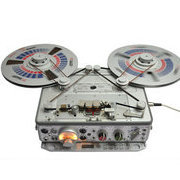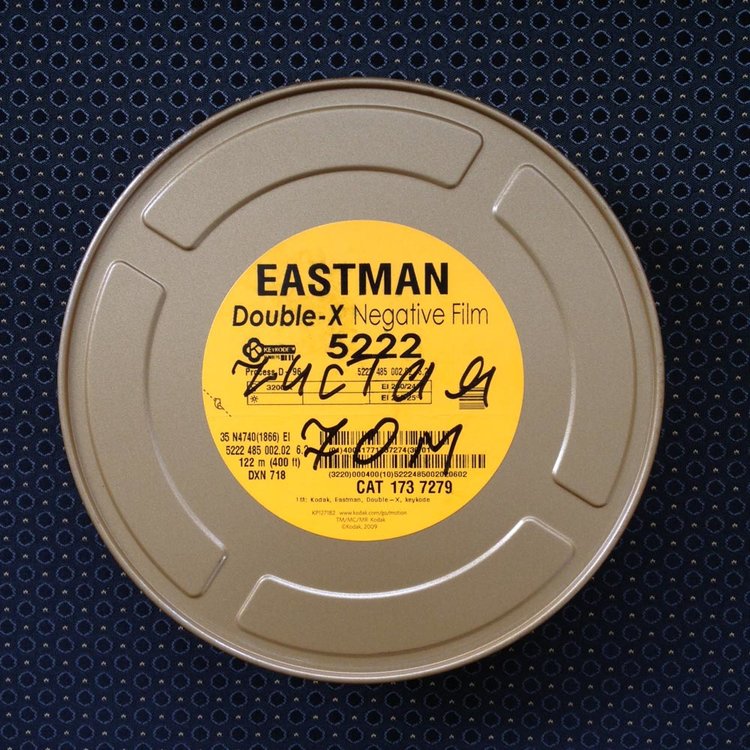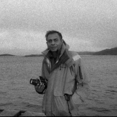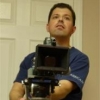Search the Community
Showing results for tags 'kodak'.
-
Hello, this is my very first post on this forum so first of all thank you all for having some time to read and answer this question. I'm going to shoot a project on S16 (arri 416 plus) next month and I don't have nearly the same experience with film than digital so I'm sorry if this sounds really newbie. Basically I'd like to know what's the real and usable dynamic range of kodak Vision3 and all the elements that affects it (print, scan, etc). I Research on this forum, internet and on Kodak's website and the numbers change considerably. Kodak says it's about 10-11 stops, then I read that the official number is 14 (this is hard to believe) and some friends told me it's about 7 stops (-3, +4). Also I wanted to know if the print and the scan are really important to save the dynamic range. I read a Kodak document that recommends to use 16bit scan when the stock is Vision3 to hold all the dynamic range in there. Also, which scanner do you recommend me? What I read the best one is DPX 16bit but it may be really expensive so I'd like to have a cheapest solution that can hold the DR of the film. Thanks!
-
I am selling Kodak Double X 35mm film short ends - 70 meters, or 230 ft. From another film production earlier this year. Purchased directly from Kodak, kept refrigerated at all times. Kodak rates it as 250asa, i shot is as 125 and got lots of details in shadows. I can ship it with USPS priority service in the US. 100$
-
I recently purchased some Kodak Vision3 re-cans and short-ends film stock. I’ve read differing opinions in regards to refrigerating versus freezing the film. Some have recommended to not freeze the film as it may be damaged from the process. Is there any general consensus as to the best practice for storing film? Kodak literature states that freezing film is an appropriate step for longer term storage (more than six months). I don’t know when I may use it and if the time period will exceed six months. Can I promptly freeze the film to slow the degradation process? With my film stock being re-cans and short-ends, I feel I should be more mindful of degradation, but with it not being in factory-sealed cans anymore should I avoid freezing? What are the best techniques to safely store new and opened film stock? Fridge or freezer? Should I place the cans in zipped plastic bags? Should I insert selica gel packets to reduce moisture? Any tips or suggestions would be helpful. Thanks!
-
Shot on Super 16. Kodak Vision3 Stocks. 200T and 50D.
-
Hello, I was wondering, how close the Vision 3 films are to each other? Of course the sensitivity and grain differ, but are there much if any differences in terms of colour, contrast and perhaps sharpness too? After all they are being advertised as being intercuttable. If the obvious things like grain are not taken into consideration, would it be impossible to distinguish the different Vision 3 stocks from each other? To a slighty other thing, if the Vision 3 films are very similar, does it make a lot of sense to have 4 stocks that practically look the same? It shouldn't be a big thing to add an extra stop of ND or an 85 filter. Kind regards, Valter
-
Just for educational purposes, here is some footage from a short I shot last year. We were stealing this, so we couldnt light anything. It's all available light. https://vimeo.com/174719862 We shot 5219 with a 2 stop push. I rated it at 1250, which gave me about a t/2 in some places, but often my meter said "E.U.", so I really wasnt sure how it would turn out. We I went in for the transfer i was very very impressed by how it held up, even with it only being 2-perf. I'm so used to thinking that you need to shoot digitally if you want to shoot available light at night, but this turned out exactly how I had hoped. We shot on super speeds at a t/1.4-2 split. The transfer was on a Spirit 2k at Fotokem in LA. We set basic looks as we went, and that's what this is, just a basic grade, right out of the scanner. If you want to download the 2.5gb 422HQ you can find it here: https://www.dropbox.com/s/n5qo2cm9au9wo7k/L9974909_CR_A15_A17.mov?dl=0 Here is the finished short: https://vimeo.com/130967218
-
Updated and reduced price from earlier this year. I currently have a small inventory of factory sealed cans of Kodak 16mm negative in storage in France. I had planned to shoot it myself, but the need is no longer there, so I'm willing to sell it at a discount. If you're interested, and located anywhere in Europe, it would be easy for me to ship it. I have in proper storage: 9 brand new sealed 400' cans of 7203 50D 1 brand new sealed 400' can of 7207 250D 200ft shortend of 7219 500T 100ft shortend of 7203 50D 240ft shortend of 7203 50D The new cans are 70 euros each and assuming someone wants to buy alll 10 cans I'll throw in all of the shortends for free. You have my guarantee they are just as shootable though. The shortends where made at the end of shooting days when film was still remaining in the camera mag but it needed to be loaded with a different stock for the following day. The rolls were cut with scissors in a changing bag and put back in their cans, still on a core. To reiterate: - 70€ / can (preferably would like all 10 purchased) + shipping Message me if interested.
-
http://goo.gl/R5ZPn0 Interesting read, but I think it got a little heavy handed against digital. Particularly that his argument about an audiences reaction to pixels vs film seems pretty moot when everything is scanned and presented on digital projectors these days. Would be interested to hear other peoples thoughts.
-
Earlier today I purchased a Kodak Instamatic M6 Super movie camera. It is missing the battery and the cover for the meter, and I am unsure of what battery it runs. I put 3 batteries into the pack on the bottom, and put a cartridge of film on it, and as dumb as it sounds, I have no idea how to turn it on. I tried pressing the trigger, but nothing happens. Is it because I do not have a battery in the meter? And if so, what is the battery I need for it?
- 1 reply
-
- Kodak
- Instamatic
-
(and 1 more)
Tagged with:
-

Fomapan R100 Kit + Kodak Tri-X 7266 failure
Roger Cambell posted a topic in Film Stocks & Processing
Hello everybody. My name is Rogers and this is my first time posting on Cinematography.com Today for a school project I attempted developing Kodak Tri-X 7266 with a Fomapan R100 Kit in a lomo tank. I followed the instructions yet the project did not work well. It appears as if the whole emulsion was removed from the base of the film leaving it clear. My problem is I can't figure out at what step this happened. Would someone have any information on what could have caused this to happen? Perhaps it was during bleaching something went wrong? Also, it would be nice to understand the re-exposure part a little bit more. This was my first time so I was expecting some chaos. Thank for reading my post and to anyone who can spare some info! -
Does anyone know if using anamorphic lenses on S16mm was common before the release of the Hawk V-Lite16 lenses? I'm looking to shoot a project on these lenses soon and am hoping to use an Aaton XTR, just wondering if it will be easy to find an anamorphic viewfinder attachment for the camera. Or if it would be better to go with a SR camera. A 416 seems to be out of the question for now due to budget reasons. I believe this camera shares the viewfinder design with the SR cameras anyway. (the 416 I used just had SR ground glass in it.) Alternatively what other (if any) Anamorphic 16mm lenses are available in Los Angeles. - M
-
I'm shooting a project on Vision 3 250D & 500T 16mm soon, we will be scanning to 2K. I've only shot 16 mil once before and am hoping to get something that will look sharper than we got last time. This is what we ended up with last time. http://www.marzmiller.com/ghost (this was also a 1080 telecine, not a 2K scan, processed normally and telecined at Fotokem) Right now I'm thinking of shooting up a stop and a half and pulling one stop, as well as some de-graining in post. Any other ideas on how to get the look I'm going for? I guess the look could best be described as I want it to look like very clean 35mm. We just don't have the dough for 35 this time. - M
-
Hello Recently purchased a Kodak Instamatic M22 off ebay for £10 with some new film, the listing stated it was not tested but i took a chance anyway. So it came and didn't work, turns out the batteries had corroded so i cleaned it out and popped in some new AA's, pressed the exposure and sure enough the motor buzzed away like a bee. However having opened up the catridge slot i could see that even though the motor was working the film cartridge turner thingy wasn't moving, after a browse online i found out these things have weak gears that break so i got out the screwdriver and took it apart, all the gears are in great condition so i don't know what could be causing this to not work. Any help much appreciated, thanks
-
Hey all, hoping for a bit of advice. Having some trouble with an approaching s16mm shoot- a darkroom scene. I was hoping to light mainly with practical florescent 2x4's and then to gel them fully red for some sequences. My question is: with the interior location, I thought I should shoot on 7219 500T... should I use tungsten tubes? Or would daylight tubes be better for the gel? I know daylight-balanced bulbs on tungsten stock will come away rather cyan, which I don't mind. But gelled, what should I expect? I could shoot on 250D, but am nervous that the light loss from the gels will give me a tough exposure. What setup of stock and bulbs (filtration?) do you think is best? Unfortunately, there just doesn't seem to be budget for tests. I also read in an older post here that there were issues with focusing, or that the image (red lit) will look soft. Is this a genuine focusing issue? Or should we just measure out as per usual? The last thing here that freaked me out was that someone noted that my light meter will give me an improper reading under these red conditions. Does anyone have any experience with this type of setup? Thanks so much for your input. Any advice would help!
- 3 replies
-
- flourescent
- darkroom
-
(and 6 more)
Tagged with:
-
Hello all, I am looking for Kodak 5219/ Fuji 8547 Recans, Short ends and factory sealed. If you have any/know where I can get them please let me know. I've already checked with the major resellers.
-
https://youtu.be/wr6NdyP4y-k?t=30m Start at 30 min or a little before that (should be there already) and enjoy. Poetry to my ears. They also mention the motion smoothing on TVs as default, film exhibition, ........... "A super 16 tap into a monitor looks like scrambled pornography from the 80's" Best quote ever from Alex Ross Perry.
-
Screening of Semi-Finalists at Slamdance Showcases Glorious Array of Super 8 Films Kodak announced the Grand Prize winners of the KODAK Super 8 Filmmaking Challenge, following a screening of remarkable works from the 15 semi-finalists’ films at the Slamdance Film Festival last night. Kodak launched the Super 8 Filmmaking Challenge in November 2015 as part of the company’s celebration of the 50th anniversary of Super 8, a beloved format that inspires content creators far and wide. The Challenge immediately struck a creative chord, and over 530 films from around the world – narrative, music videos, experimental, classic surf and skate, documentaries, archival, fashion, and home movies – were submitted. The films showcase the robust depth of talent among filmmakers, both professionals and amateurs alike, as well as the diverse range of the capabilities of Super 8 as a unique storytelling tool. Filmmakers entered both vintage and new work in one of three categories: POV, Action and Flashback. From the original entries, 15 semi-finalists were chosen through online audience voting and juried selection. Those 15 semi-finalists, who earned a hosted screening at the esteemed Slamdance fest, competed again in a global online audience vote, which determined the final first, second and third place audience winners. Boasting prizes valued at $12,500, the Grand Prize Audience winners of Kodak’s inaugural online contest are: 1. Pablo Madrid Lopez from Spain for THE NOVEL, receiving a prize package that consists of a KODAK PixPro SP360 Action Camera, a Rhonda CAM Super 8 Camera from Pro8mm, 10 Pro8mm Super 8 film kits, approximately $2,000 retail value of KODAK motion picture film of the winner’s choosing, and a KODAK t-shirt. 2. Haven Nutt from the United States for the MR. MAN trailer won a KODAK PixPro SP360 Action Camera, six Super 8 film kits, and a KODAK t-shirt. 3. Dianne Ouellette from Canada for RED IS DEAD takes home a KODAK PixPro SP360 Action Camera, three Pro8mm Super 8 film kits, and a KODAK t-shirt. Renato Coelho from Brazil, who directed TRAIN, won the Grand Jury Award, which was chosen by a panel of respected industry professionals. Judges included cinematographer Rachel Morrison; photographer Elliott Landy; writer-producer Josh Friedman; Glenn Gainor, head of physical production at Sony Screen Gems; Leslie Raymond, executive director of the Ann Arbor Film Festival; and Pro8mm founders Phil and Rhonda Vigeant. Coelho earns an identical prize package as the first place Grand Prize Audience winner. “Jurying the Super 8 Challenge allowed me to reconnect with the medium and see the variety of creative exploration,” said Raymond, who led the jury. “I am excited to see it persisting as a member of the film family.” At the Consumer Electronics Show (CES) in Las Vegas earlier this month, Kodak announced an initiative to support Super 8 film into the future. The company introduced a prototype of a new Super 8 camera, and revealed plans for creating an ecosystem that includes a range of cameras, film development services, post production tools and more. “Kodak is resolute in our efforts to ensure film continues to be an option for filmmakers passionate about using it for all levels of content creation,” said Sascha Rice, Global Marketing Director for Kodak’s Entertainment Imaging Division. “The response to this contest and to the new Super 8 camera has been overwhelmingly positive, and the momentum to shoot on film is palpable. Kodak is honored to be here to support and advance these artists’ creativity.” To discover recent movies, television, and music videos shot on 8mm, 16mm, 35mm, and 65mm film, go to: www.kodak.com/go/shotonfilm.
-
- Kodak
- Film Festival
-
(and 7 more)
Tagged with:
-
Here is my new article on Super 8 which was written before all the new announcements: http://www.redsharknews.com/production/item/3180-shooting-on-super-8-in-the-21st-century Sadly a lot of the links got lost somewhere in editorial which takes away from the usefulness slightly but I'm sure you can all google for the missing sites. There's a lot of info here on how can work with Super 8 cheaply right now. Should be helpful if combined with some local info. Freya
- 6 replies
-
- Super 8
- getting started
-
(and 1 more)
Tagged with:
-
Hey guys, I found a write-up about this in the Incamera Kodak magazine about this short film shot on 2 perf 35 mm and I just have to share it here because I think it's really superb and probably one of those very few shorts that leaves an impression on me.
-
I had the privilege to attend CES to witness the new Kodak's Super 8 Film Camera. Most important, they kindly allowed me to hold it in my hands. I couldn’t help myself falling in love with it at first sight. MOY
- 45 replies
-
- 1
-

-
- Super 8
- Film Camera
-
(and 1 more)
Tagged with:
-
http://theaudienceawards.com/films/lights-and-shadows-oshea-brothers52174 Comprised over 6 years of shooting Kodak Motion Picture Film, "Lights and Shadows" is my love letter to film as well as skateboarding. Shot on discontinued plus-x and 100D reversal as well as the gorgeous Vision 3 color negative stocks. I really hope the members of the cinematography.com community will take the time to view my film submission and vote in my favor as I'd love to continue shooting film for all of my future projects. Thanks! - Hunter O'Shea
-
Easy to Use, Digitally Controlled Method Redefines Vital Process ROCHESTER, NY (Dec. 21, 2015) - Kodak has announced the release of a new, groundbreaking P-200 Film Cleaning System that transforms the traditional film cleaning process. The revolutionary design allows the cleaning solvent to be dispersed on the film surface in a unique way. This economical, compact and digitally controlled system, which uses KODAK HFE 7200 Film Cleaner Solution, makes it ideal for today's archives and libraries. Proper film cleaning is vital to both archiving and restoration. In most cases, film needs to be cleaned before being stored in a library and prior to being digitized. Now, with the KODAK P-200 Film Cleaning System, institutions responsible for media collections can maintain their valuable film assets to the highest standards for a very small investment and very minimal infrastructure requirements. "Knowing the importance of proper film cleaning to both maintaining and digitizing film content, Kodak has developed a system for the 21st century," noted Antonio Rasura, technical manager of Kodak's Consumer and Film Division. "It's small in size, environmentally friendly, and easy to use, with no need to directly handle solutions. Maintenance is also simplified, so it can be used in both traditional laboratories and in-house by institutions." The KODAK P-200 system consists of a compact machine that measures only 31w x 21d x 51h inches with touchscreen controls for navigating the operating modes. It uses KODAK HFE 7200 Film Cleaner Solution, an environmentally safe solvent with a zero ozone depleting classification, and a very low toxicity rating (near zero). Adding to the system's efficiencies, Kodak is offering the solvent in low quantities for the first time, eliminating the need to invest in large orders of film cleaning supplies. "The way the machine disperses the solvent onto the film is very unique," said Rasura. "Solvent is quite expensive, and we didn't want to use a costly recovery technique for the cleaner solution. The system we have developed atomizes the solvent, utilizing highly efficient delivery jets that 'fog' the film with an extremely fine dispersion of the HFE. The results include a huge amount of coverage with very little solvent, and all with no hazard to the operator or the environment." The KODAK P-200 Film Cleaning System also offers Variable Speed Precision Tension Control, a laser-guided feature that can operate with speeds of 50-200 fpm while maintaining consistent and even tension throughout the wind of the roll, which is especially beneficial for long-term archiving. "Film is an integral component of our industry and cultural heritage, and Kodak recognizes the need to support and preserve that content," added Andrew Evenski, Kodak's president and general manager of Entertainment & Commercial Films. "Our aim in bringing this new system to market is to ensure that the community's needs for accessible, quality film cleaning are met at an affordable price point."
-
Voting for the Audience Awards Now Open to the Public LOS ANGELES (December 22, 2015) - Kodak has enlisted an elite list of filmmakers, a photographer and industry professionals to be judges for the Kodak Super 8 Filmmaking Challenge. The competition, launched in November, has received over 500 entries submitted by a wide range of Super 8 content creators around the world. There are two rounds of judging for the Jury Awards, with votes being cast by cinematographer Rachel Morrison, photographer Elliott Landy, producer Glenn Gainor, writer-producer Josh Friedman, film festival director Leslie Raymond, and Pro8mm founders Phil and Rhonda Vigeant. Fifteen semi-finalists will be chosen in the first round of judging and revealed December 29. The jury will choose two of those winners from each category - POV (fiction), Action (lifestyle) and Flashback (non-fiction) - with the remaining three winners from each group chosen by audience voters. The clips by all 15 semi-finalists will be shown at a special screening hosted by Kodak at the Slamdance Film Festival on January 25, 2016, where the final four winners will be announced. The victors will consist of the top three voted films and one juried film. All semifinalists and finalists win prizes, which range from a KODAK PIXPRO SP360 Action Camera and a Pro8mm Rhonda Super 8 camera, to film stock, processing and swag, valued at up to $12,500. The Kodak Super 8 Filmmaking Challenge is hosted on The Audience Awards contest platform. Viewers can sign up for free to watch and vote for their favorite clips from December 22 to January 25, 2016. Morrison is a highly regarded cinematographer, known for her compelling visuals on Fruitvale Station, Cake, Little Accidents and Dope. Landy has made his mark in the art world with his iconic photographs of rock musicians. Gainor serves as president of physical production for Sony Pictures' Screen Gem, overseeing such movies as The Perfect Guy and About Last Night, among dozens of others. Friedman is currently adapting Bong Joon-ho's Snowpiercer for television, and at work on the script for the Avatar sequels. Raymond is the executive director of the annual Ann Arbor Film Festival in Michigan, and the Vigeants founded and operate Pro8mm in Burbank. Kodak launched the Super 8 Filmmaking Challenge in celebration of the 50th anniversary of Super 8 film this year. "The unique qualities of this film format have inspired content creators for decades, demonstrated by the hundreds of submissions we've received that showcase the glorious array of Super 8 filmmaking," says Sascha Rice, global marketing director for Kodak's Entertainment Imaging Division. "Filmmakers have submitted both vintage and new work. Now, through online audience voting and juried selection, 15 semi-finalists will be selected from a fantastically diverse retrospective of works including narrative, music videos, experimental, classic surf and skate reels, documentaries, archival footage, fashion, and home movies. Kodak is honored to support these filmmakers and applauds their spectacular expressions of art and storytelling." For more information, visit the Kodak Super 8 Filmmaker Challenge. To discover more movies, television shows, and music videos shot on film, go to www.kodak.com/go/shotonfilm.
-
So the other morning, while driving home from work, I received an unsolicited LinkedIn message notification on my phone...from the new President of Kodak's Motion Picture Entertainment Division, Steve Bellamy. Needless to say, I initially thought this was some sort of prank. But after checking a few things, I realized this was the real deal. We exchanged another e-mail in which he gave me a number that he wanted me to call him at. In short, he struck me as a very polite, easy-going person with a lot of knowledge. He said that since he became president, he's been doing a lot of searching on the internet for filmmakers who are passionate about analog film-making and randomly contacting them. He said he appreciated what he called "well-written" pages I've put up on the web and wanted to hear more about my particular passion for film. I told him how the grain and chemical processes simply make it more of an organic medium, and that the contrast & overall picture still produce a better final product, in my view. More importantly, I mentioned how I am a big film history buff and that many flash-in-pan "film-makers" these days who grab a DSLR, shoot something on digital and post it to Youtube, have little to no sense of film history, much less any sense of pre-visualization. And it shows in the work. To be fair, I did tell him how I am anxious to experiment with some of the more advanced digital technology - namely the Alexa, since I feel it is the best at capturing a film-like image. He agreed with film being a discipline and that there is still no replacement for it. It was interesting to hear about his passion for the medium but admitted that it’s not cheap. However, we both agreed that in comparing it to a digital project, people tend to spend even more for the post-production processes than they would for a properly budgeted analog project. He said that he is all about choice and has nothing against digital. To paraphrase what he said, “If that’s your preferred medium, more power to you.” Lastly, he asked me to put together a 3-5 minute interview of myself and talk about why I love film. He said that he’s getting independent film-makers like myself, as well as people like Christopher Nolan, Steven Spielberg and Quentin Tarantino to do the very same thing. He’s not sure exactly what form it will take just yet (possibly web-based or a documentary format) but it’s something he wants to put together to show just how many people are still passionate about film. So yeah…that was pretty cool and unexpected. :)









